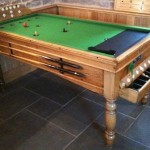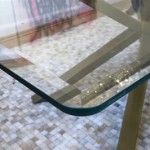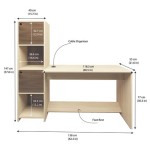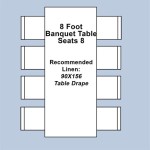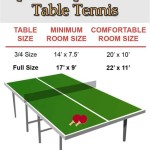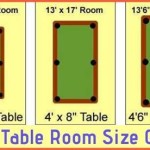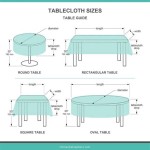DIY Glass Dining Table Base Ideas: A Comprehensive Guide
A glass dining table offers a sleek and modern aesthetic to any dining space. Its transparency allows natural light to permeate, creating an airy and spacious feel. However, the visual impact of a glass tabletop is largely dependent on the base upon which it rests. Selecting an appropriate base is crucial not only for structural integrity and stability but also for achieving the desired design statement. Opting for a do-it-yourself (DIY) approach to crafting a glass dining table base provides an opportunity for personalization, cost savings, and the satisfaction of creating a unique piece of furniture.
This article explores various DIY glass dining table base ideas, providing practical considerations, design inspirations, and construction techniques to help individuals embark on their own furniture-making journey. The information presented aims to empower readers with the knowledge necessary to select materials, conceptualize designs, and execute a successful DIY project.
Key Considerations Before Starting Your DIY Project
Before diving into specific design ideas, it is essential to address several fundamental aspects that will influence the project's success. These considerations encompass safety, material selection, and structural integrity.
Safety First: Glass, while visually appealing, can be fragile and dangerous if mishandled. When working with glass tabletops, it is imperative to wear appropriate safety gear, including eye protection and gloves. Exercise caution when moving and positioning the glass to prevent accidental breakage. Furthermore, the chosen base design must ensure the glass is securely supported and cannot easily tip over or shift under normal conditions. Consider the thickness of the glass and its weight when planning the base. Thicker glass will be heavier and require a sturdier base.
Material Selection: The choice of material for the base will significantly impact the table's overall aesthetic and durability. Popular options include wood, metal, and concrete, each offering distinct advantages and challenges. Wood provides warmth and versatility, allowing for intricate carvings and custom finishes. Metal offers strength and a modern industrial look, while concrete provides a robust and contemporary feel. Selecting the right material requires careful consideration of the desired aesthetic, the level of skill and tools available, and the budget.
Structural Integrity: The primary function of the base is to provide stable support for the glass tabletop. The design must ensure even weight distribution and prevent any wobbling or instability. The dimensions of the base should be proportionate to the size and shape of the glass. A small or flimsy base will not adequately support a large or heavy glass top, leading to potential safety hazards. Careful planning and precise execution are critical to ensure the base is structurally sound and capable of withstanding the intended use.
Creative DIY Glass Dining Table Base Designs
With a solid understanding of the fundamental considerations, it is time to explore various DIY glass dining table base ideas. These suggestions provide a starting point for individuals to adapt and personalize based on their specific needs and preferences.
Wooden Beam Base: A rustic and charming option involves repurposing reclaimed wooden beams to create a unique table base. The natural imperfections and character of the wood add warmth and visual interest. The beams can be arranged in a variety of configurations, such as a simple trestle design, a geometric pattern, or a more elaborate sculpted form. Ensure the beams are properly sanded and sealed to protect them from moisture and wear. The top surface of the beams, where the glass will rest, should be carefully leveled to ensure a stable and even surface. Fastening methods will vary depending on the specific beam arrangement, but typically involve screws, bolts, or wood glue.
Metal Pipe Base: For a modern industrial aesthetic, a metal pipe base offers a robust and visually striking option. Black iron pipes are commonly used due to their availability and rugged appearance. The pipes can be connected using threaded fittings to create a variety of geometric designs, such as a rectangular frame or a more complex network of intersecting pipes. Ensure all connections are securely tightened to prevent any wobbling or instability. The metal pipes can be left unfinished for a raw industrial look or painted to complement the surrounding decor. Consider adding floor protectors to the bottom of the pipes to prevent scratching the floor. Glass mounting hardware, such as adhesive pads or rubber bumpers, will be necessary to ensure the glass rests securely on the pipe frame.
Concrete Pedestal Base: A concrete pedestal base offers a contemporary and minimalist look. This option requires some experience with concrete casting and formwork. The base can be cast in a variety of shapes, such as a simple cylinder, a tapered cone, or a more sculpted form. The concrete mix should be properly proportioned to ensure strength and durability. Reinforcement, such as steel rebar or wire mesh, can be added to increase the base's structural integrity. After the concrete has cured, the formwork is removed, and the surface is polished to achieve a smooth and refined finish. The top surface of the concrete pedestal must be perfectly level to provide a stable platform for the glass tabletop. A suitable adhesive can be used to bond the glass to the concrete, or a recessed channel can be created in the concrete to accept the glass edge.
Upcycled Material Base: Unleash creativity by repurposing unexpected materials to create a truly unique table base. Examples include stacks of vintage suitcases, reclaimed metal gears, or even a collection of interesting rocks or stones. The possibilities are endless, limited only by imagination and resourcefulness. When using upcycled materials, it is essential to ensure they are structurally sound and capable of supporting the weight of the glass. The materials may need to be modified or reinforced to ensure stability. Consider the visual impact of the chosen materials and how they complement the glass tabletop and the overall design aesthetic. Securing the glass to the upcycled base may require custom-made brackets or adhesive pads.
Hairpin Leg Base: Hairpin legs, typically made of steel, offer a minimalist and mid-century modern aesthetic. They are readily available in various sizes and finishes, making them a convenient option for DIY projects. Attaching hairpin legs to a wooden platform or frame provides a simple yet stylish base for a glass tabletop. The legs can be easily screwed into the platform, creating a stable and visually appealing foundation. Ensure the platform is properly sized and constructed to provide adequate support for the glass. Consider the height of the hairpin legs when determining the overall table height. Glass mounting hardware is recommended to prevent the glass from sliding off the base.
Construction Techniques and Tips
Regardless of the chosen design, several fundamental construction techniques and tips apply to all DIY glass dining table base projects. These guidelines will help ensure a successful and satisfying outcome.
Accurate Measurements: Precision is paramount when constructing any piece of furniture. Accurate measurements are essential for ensuring the base is properly sized and proportioned to the glass tabletop. Double-check all measurements before cutting or assembling any materials. Use a reliable measuring tape or ruler and a set square to ensure right angles are accurate. Consider the thickness of the materials when calculating dimensions to avoid errors.
Strong Joinery: The joints between the various components of the base must be strong and durable to ensure stability. Choose appropriate joinery techniques based on the materials used and the desired aesthetic. Woodworking joints can include mortise and tenon, dovetail, or dowel joints. Metal joints can be welded or secured with bolts and screws. Concrete joints can be reinforced with rebar or bonded with specialized adhesives. Ensure all joints are properly aligned and securely fastened before proceeding to the next step.
Smooth Surfaces: A smooth and even surface is critical for ensuring the glass tabletop rests securely and without any stress points. Sand all wooden surfaces thoroughly to remove any splinters or imperfections. Grind and polish concrete surfaces to achieve a smooth and refined finish. Deburr metal edges to prevent any sharp edges that could damage the glass. Apply a protective finish to all surfaces to prevent moisture damage or corrosion. Use a leveling compound to ensure the top surface of the base is perfectly level.
Secure Fastening: The method of fastening the glass to the base will depend on the chosen design and materials. Options include adhesive pads, rubber bumpers, custom-made brackets, or recessed channels. Adhesive pads provide a simple and convenient way to secure the glass to the base. Rubber bumpers provide cushioning and prevent the glass from sliding. Custom-made brackets can be designed to provide a more secure and aesthetically pleasing attachment. Recessed channels can be created in the base to accept the glass edge, providing a clean and integrated look. Ensure the chosen fastening method is strong enough to support the weight of the glass and prevent any movement.
Finishing Touches: The finishing touches can significantly enhance the overall appearance of the table base. Apply a protective finish, such as paint, stain, or varnish, to protect the materials and enhance their aesthetic appeal. Consider adding decorative elements, such as metal accents, carvings, or inlays, to personalize the design. Install floor protectors to prevent scratching the floor. Carefully inspect the finished product for any imperfections and make any necessary adjustments. The goal is to create a functional and visually appealing piece of furniture that will be enjoyed for years to come.
By considering these DIY glass dining table base ideas and construction techniques, individuals can create a unique and personalized dining table that reflects their individual style and craftsmanship. The process requires careful planning, attention to detail, and a commitment to safety, but the rewards are a one-of-a-kind piece of furniture and the satisfaction of a successful DIY project.

10 Diy Table Base Ideas For Glass Tops

40 Glass Dining Room Tables To Revamp With From Rectangle Square

40 Glass Dining Room Tables To Revamp With From Rectangle Square

Diy Glasstop Dining Table Tutorial House Of Jade Interiors Blog Glass Room Unique

Diy Base For Glass Top Dining Table Best 25 Bases Ideas Only On Custom Room

40 Glass Dining Room Tables To Revamp With From Rectangle Square

30 Ways To Incorporate A Glass Dining Table Into Your Interior Digsdigs

40 Glass Dining Room Tables To Revamp With From Rectangle Square

Base For Glass Table Top Tonuse With Granma And Grandpas Old In Garage Dining Bases Diy Pedestal

30 Ways To Incorporate A Glass Dining Table Into Your Interior Digsdigs

